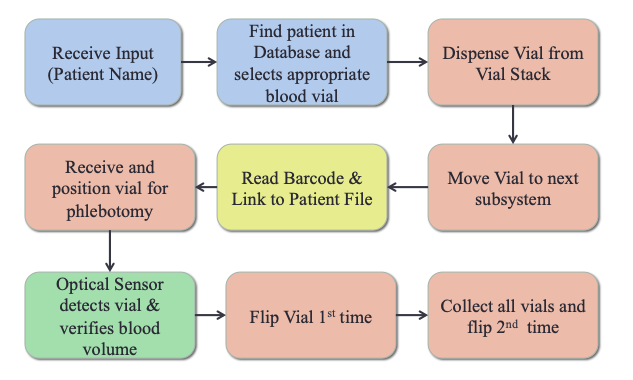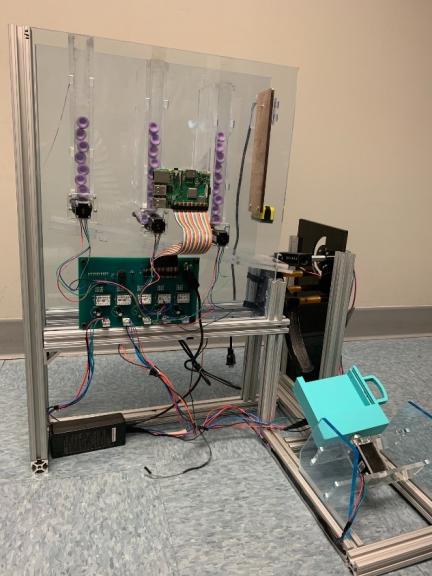PhleAid™: Automated Phlebotomy Assistant
Every year, around 0.5% of laboratory test results turn out erroneous and negatively affect the healthcare of around 2,000,000 people. Inaccurate results often come from mistakes that occur before or during the blood collection process. Some of these pre-analytical errors include:
- Inappropriate blood vial selection
- Blood vial improperly labeled or mislabeled
- Insufficient blood sample volume
- Inadequate blood sample due to clotting, hemolysis and lipemia
There are some solutions in the market that aim to minimize these errors, but most only focus on one specific error. There is a gap in the market for robotic technology that provides a solution to reducing all the potential errors. Incorporating technology into phlebotomy has the potential to remove human error that may lead to an inaccurate laboratory test.
To reduce the occurrence of pre-analytical errors, PhleAidTM, an automated assistive device, was created. Its mechanisms address these errors and minimize human contact with the blood vials. Overall, PhleAid can:
1. Correctly select the blood vials to be filled according to the tests needed by the patient
2. Label each vial by linking a patient’s information with the corresponding vials
3. Minimize the phlebotomists’ contact with the vial while steadily positioning the vial during blood collection
4. Verify the sample is adequate by means of sensor readings
Key Features/Benefits
PhleAidTM was designed to be the most beneficial solution for every party involved in the blood collection process. It assists phlebotomists by reducing the number of small tasks they do during the blood collection process. One example is inverting the vials repeatedly after collection, which is an important step to prevent damaging the blood sample. More importantly, it limits the phlebotomist’s physical interaction with the vials, an important step in preventing some of the erroneous lab test results. By doing so, this device reduces the probability that a patient will require returning to the laboratory to repeat the phlebotomy procedure - saving time, money and resources. Another benefit of using PhleAidTM is that it includes electronic components that simplify important steps during the phlebotomy process such as selecting the correct type of vial and matching patient data with vials. Its’ simple, user friendly graphical user interface sends a signal to the device and draws out the correct vials according to the patient’s needs. The device also includes a barcode scanner, which labels each vial to match it to its corresponding patient, making it easier to keep track of the patient’s record.
Incorporating technology into the phlebotomy process can also help reduce any human error present. The pre-analytical phase and the errors that occur here are a challenge that robotics and automation has not yet fully solved. There is a lack of robotic solutions that attempt to minimize pre-analytical errors in the ENTIRE phlebotomy procedure. Some marketed solutions solve individual problems in specific stages of phlebotomy. For example, those used for labeling, dispensing and scanning. There are currently various options in the market for vial labeling, including Ink, Laser or Label Printers. For dispensing there are different designs that have been developed for vial handling devices. Scanning options include camera or laser-based scanners. However, these solutions handle the individual errors in phlebotomy. Incorporating them into one device can be a simpler approach to help minimize the occurrence of errors. There is a market gap for solutions that use robotic technology to reduce many pre-analytical errors all at once not just individually.

PhleAid™ Subsystems and Functions

PhleAid Final Prototype